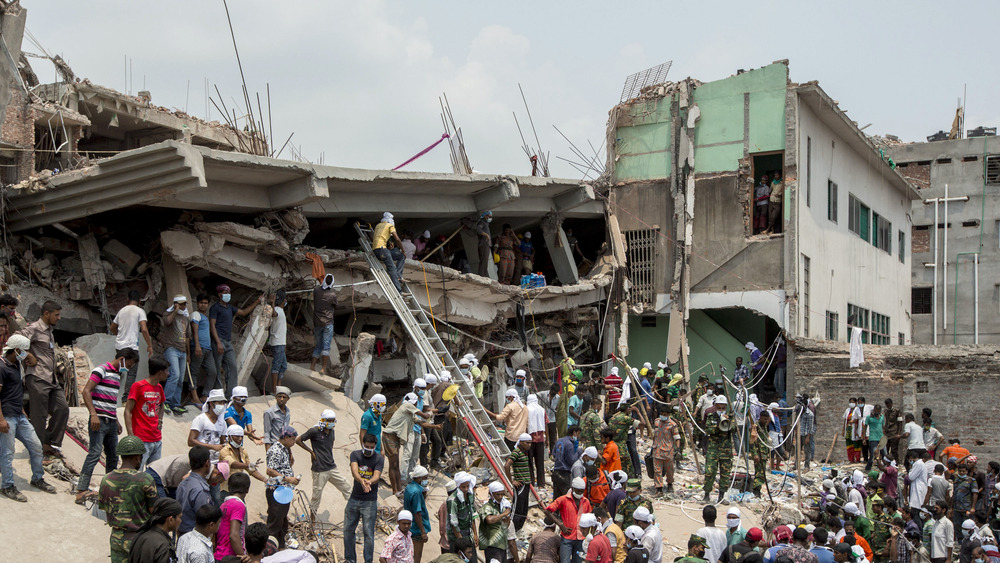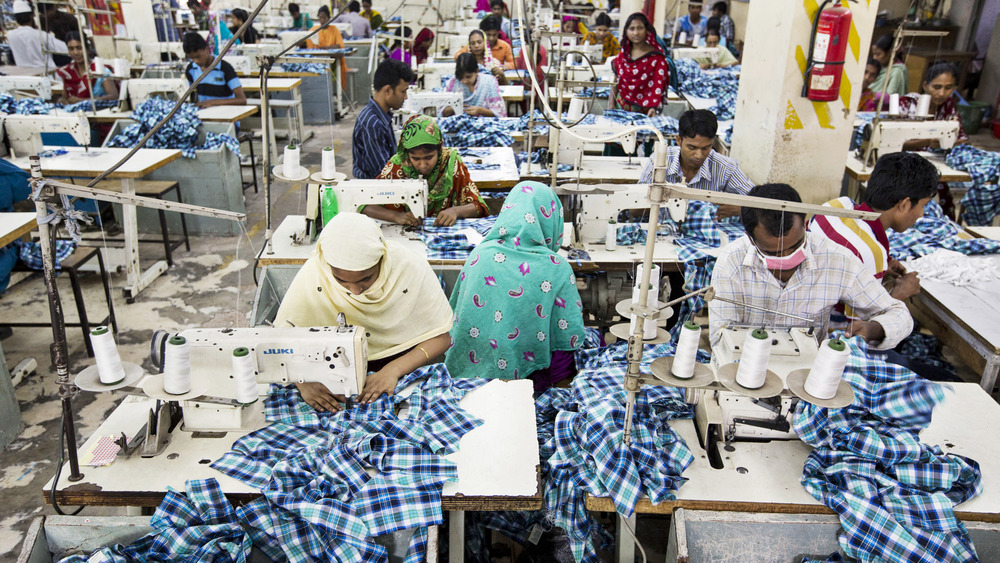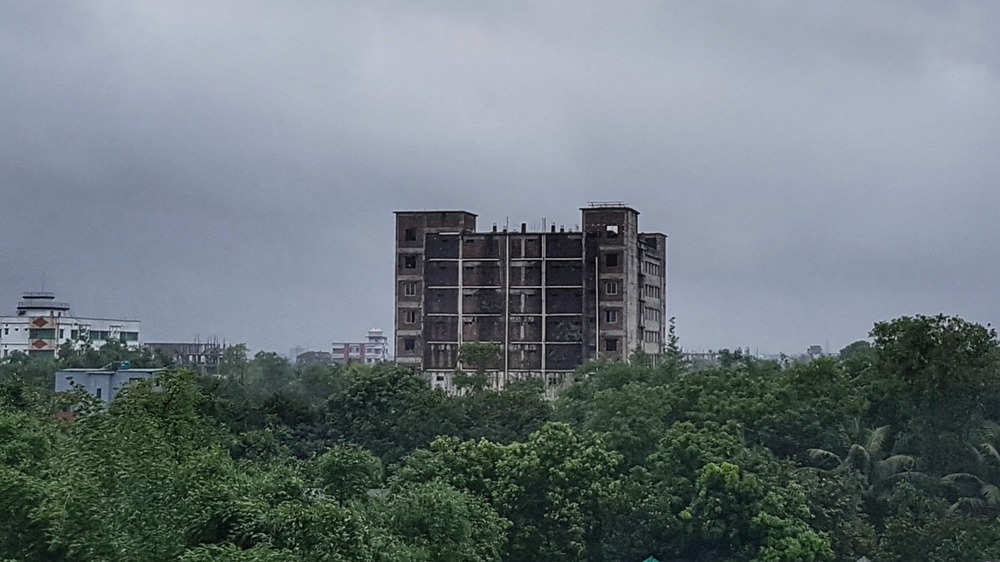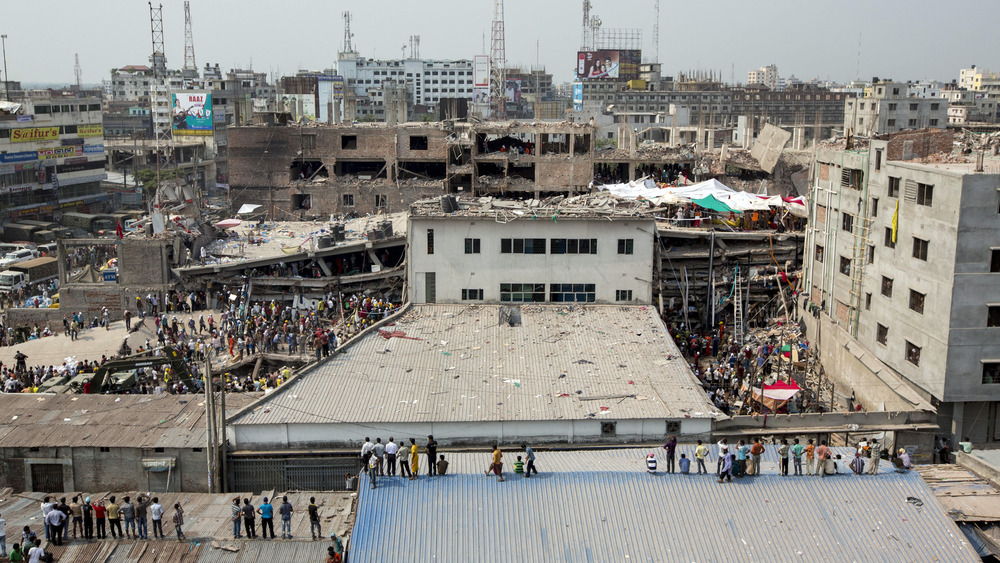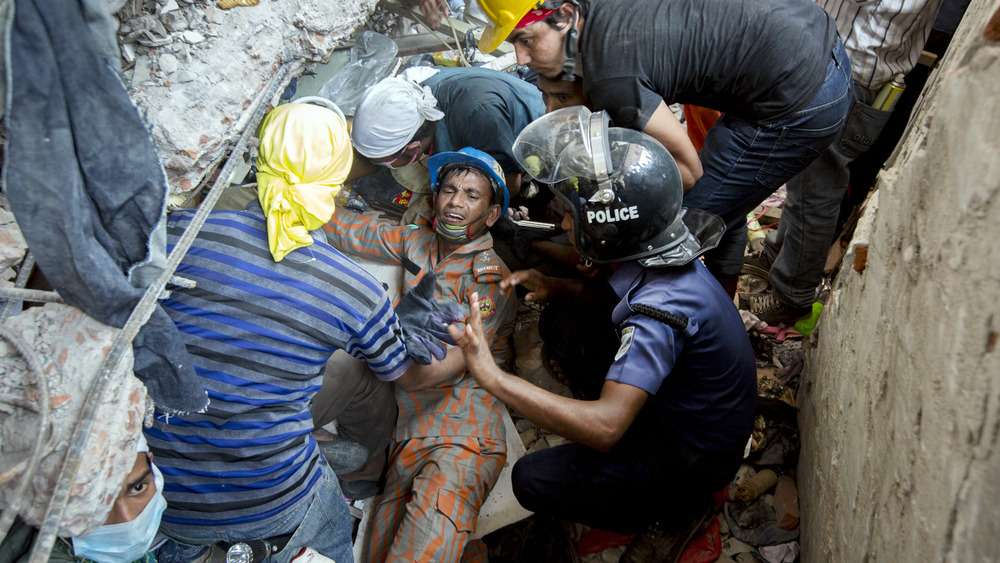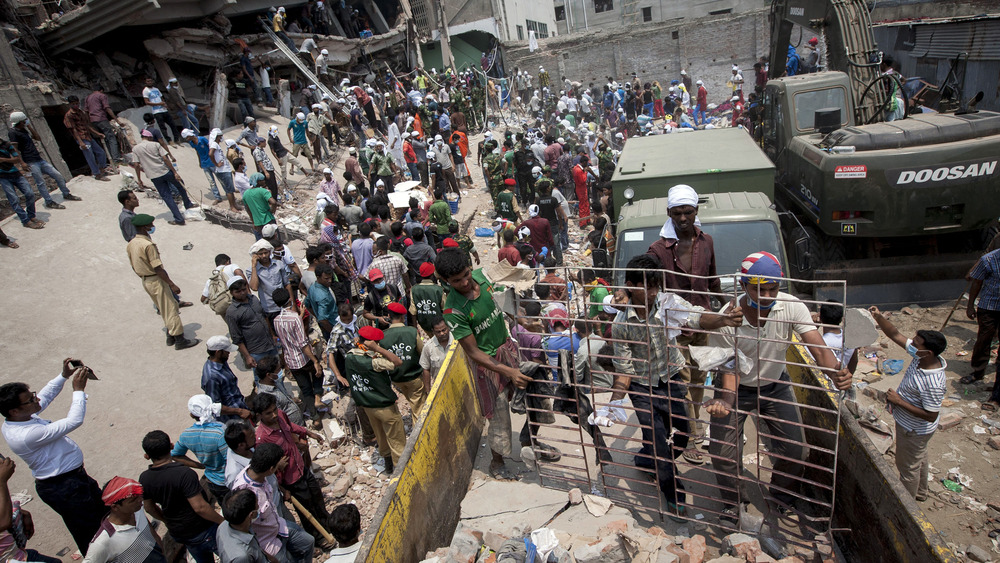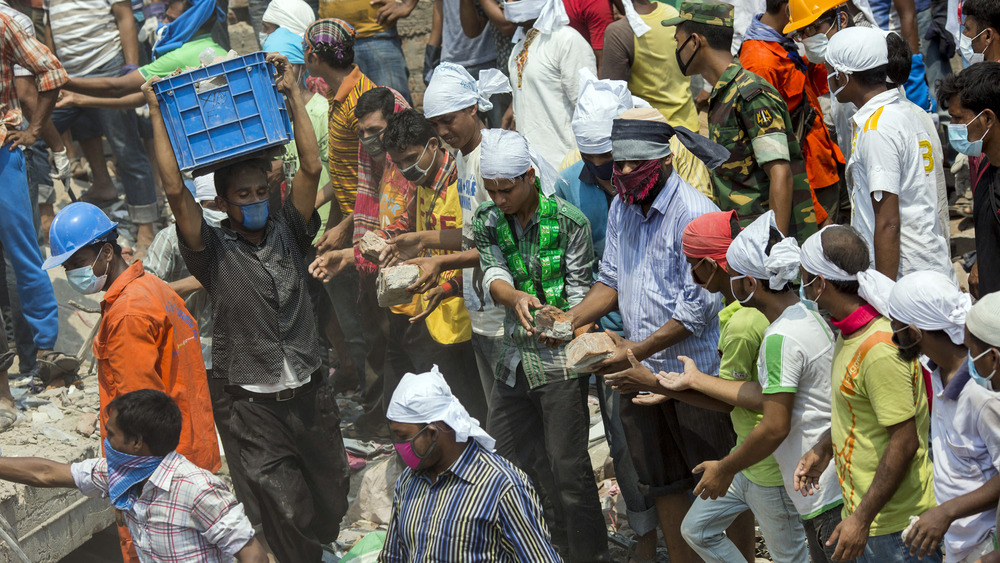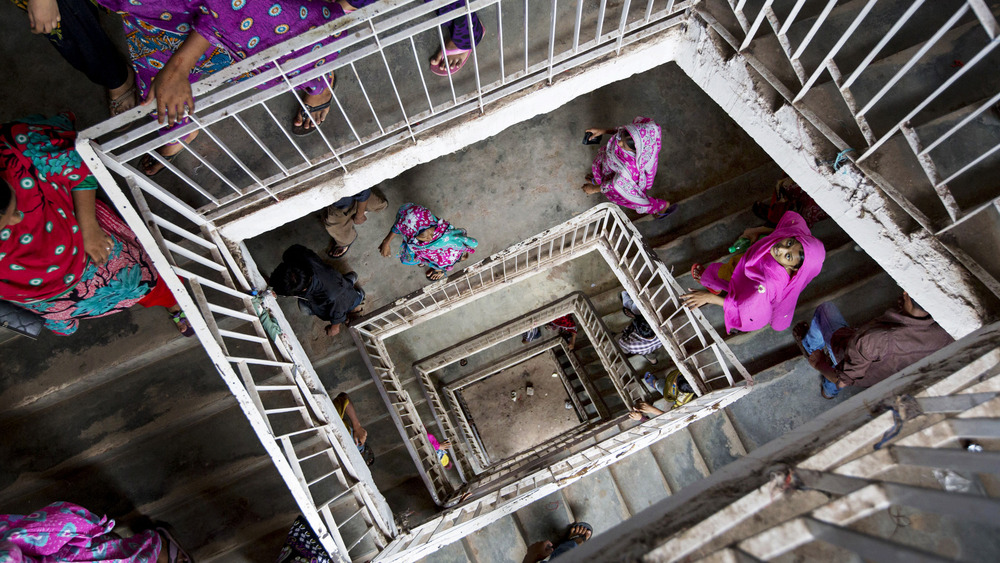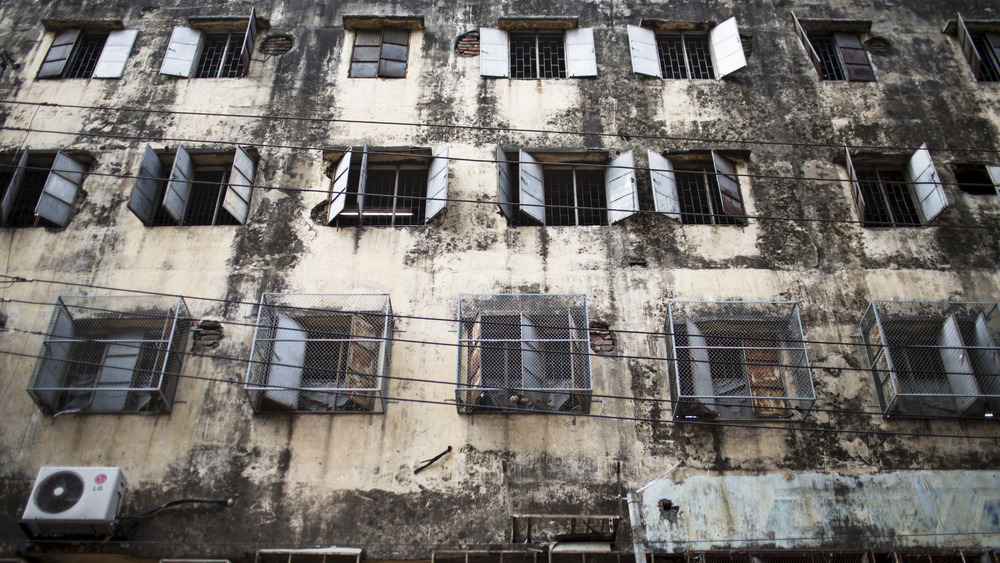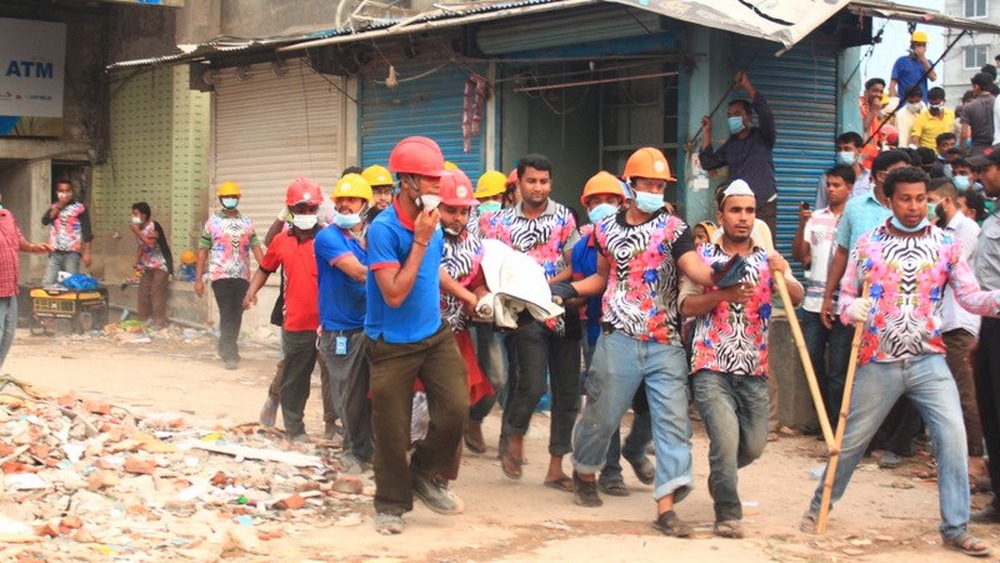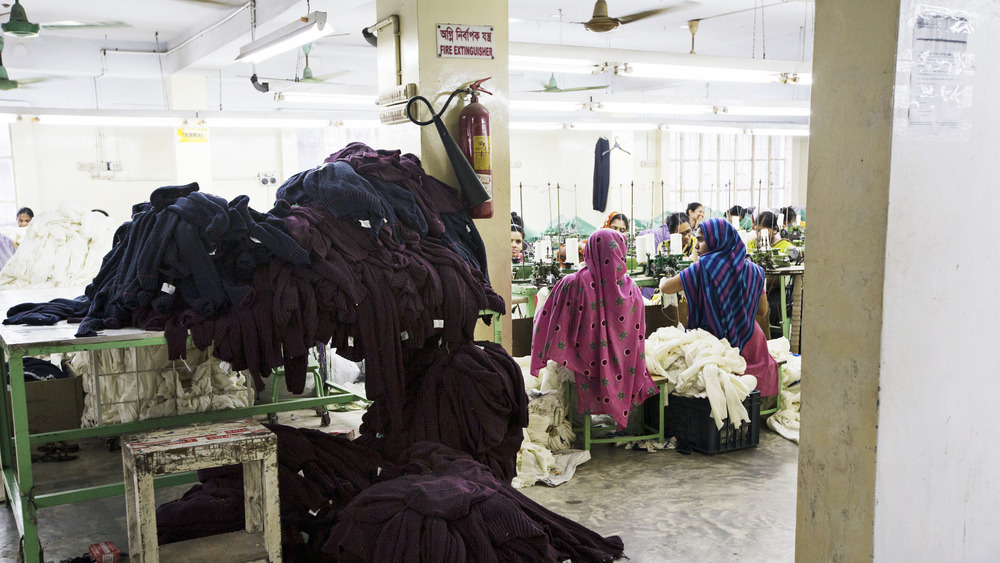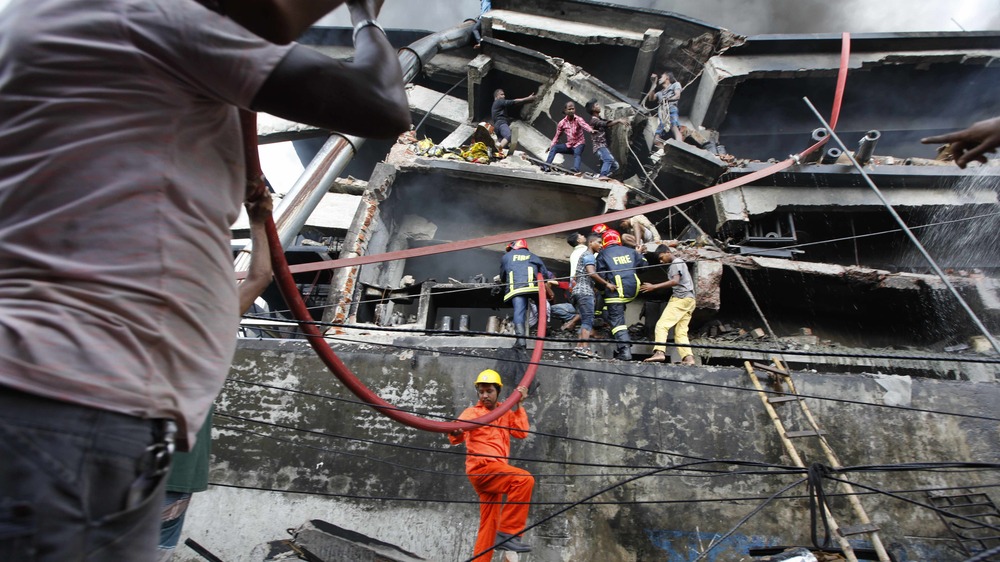The Tragic True Story Of The World's Largest Garment Factory Collapse
While the 2013 Dhaka garment factory building collapse was neither the first nor the last factory building collapse in Bangladesh, it was the deadliest garment industry accident in modern history, says The New York Times. The death toll was so massive that labor activists were finally able to convince factory owners and western retailers to take factory safety concerns seriously.
But despite the changes made towards enforcing factory safety, some of the organizations that claim to have the safety of their workers in mind continue to overstate their progress, writes the Clean Clothes Campaign, and sacrifice safety for profit. And although numerous regulations have been installed, often there aren't enough inspectors to enforce them.
The current Bangladesh Accord for Fire and Building Safety is set to expire in 2021, and despite its shortcomings, many labor activists fear that without it, many of the strides made in workplace safety will be lost. This is the tragic true story of the world's largest garment factory collapse.
The garment industry in Bangladesh
In 1978, there were only nine export-oriented garment manufacturing facilities in Bangladesh. As of 2021, after China, Bangladesh is the second largest manufacturer and exporter of garments in the world, employing millions of people. According to the IFC, this industry accounts for 80% of Bangladesh's total earnings from exported goods. It's estimated that there are upwards of 7,000 garment factories in the country and overall at least 80% of the workers are women, reports Reuters.
Despite the widespread nature of the industry and the numerous foreign businesses that engage with the factories, workers in the factories face many issues in the workplace ranging from wage theft to unsafe working conditions. Some issues have found themselves exacerbated during the 2021 COVID pandemic, such as how retailers in the west tried to steal $40 billion from garment workers, TruthOut reports.
Prior to the 2013 Dhaka garment factory building collapse, safety problems were rampant in Bangladeshi garment factory buildings. Some had electrical issues, a lack of fire exits and sprinkler systems, or all of the above. Many also showed clear signs of structural integrity issues, but when workers voiced their concerns, they were ignored.
According to The Conversation, workers also face everyday health threats, such as lack of ventilation, exposure to chemical adhesives, and smoke inhalation. "[They have] to make a trade-off between earning a living and caring for their health, which can rapidly depreciate during their working lives, undermining their long-term physical and mental well-being."
The 2012 Tazreen factory fire
On Nov. 24, 2012, a fire broke out in the Tazreen Fashion factory near Dhaka, Bangladesh. More than 200 people were injured in the fire and at least 110 workers were killed, says CNN. At least nine people died "by jumping from the building." According to The Conversation, the fire was most likely caused by a short circuit on the ground floor, but it's still unclear if the fire was accidental or sabotage.
Regardless of how it started, the fire quickly spread up the nine floors of the building, and many people ended up trapped inside as they tried to escape. Associated Press reports that "when the fire broke out, managers and security guards told workers it was part of a regular drill and it was too late for many to escape. Workers found the gates locked from outside as the fire engulfed the sprawling building." As of 2021, the Tazreen factory fire remains the deadliest factory fire in Bangladeshi history.
Despite the fact that several people, including the Tazreen Factory owners, were arrested on homicide charges, as of November 2020 "the court has recorded depositions of only eight prosecution witnesses out of 104," writes Dhaka Tribune.
This wasn't the first factory fire to claim the peoples' lives. In 2006, 84 people were killed in Chittagong due to blocked fire exits. And in September 2012, just months before the Tazreen factory fire, over 280 people died in a factory fire in Karachi, Pakistan, writes The Guardian.
Foreboding cracks
On April 23, 2013, cracks appeared in the Rana Plaza factory building in the Savar Upazila of Dhaka District. In addition to four garment factories on the top floors, the building also housed "some shops and a bank," according to National Geographic.
The garment factories employed thousands of people, and because of the regular power outages, large power generators were placed in the top factory floor. Whenever these generators were switched on, they'd often cause the building to shake. This time, when the generators were turned on, The New York Times reports that workers were alarmed enough by the shaking of the building and the subsequent cracks to rush out of the building. An engineer was called, and even they determined that the building was unsafe.
"An engineer who had been called to inspect the structure warned that it was unsafe. Yet Mr. Rana and the factory bosses discounted any concerns and ordered their workers into the building the next morning."
According to The Guardian, the next morning, managers argued with garment workers who didn't want to go inside the building. A mother of one of the workers said "her 18-year-old daughter, Rubina, was told if she didn't show up for work that day then she would not be paid for the month." Workers were told that the cracks had been examined and that everything would be fine.
Only the ground floor remained
Around 9 a.m. on April 24, 2013, the Rana Plaza factory building collapsed, reducing eight stories of concrete to rubble, reports the BBC. After the collapse, the only thing left intact was the ground floor. In the span of 90 seconds, hundreds of people were suddenly trapped "under thousands of tonnes of rubble," writes The Guardian, and while many were rescued, by the first day it was clear that the death toll was well over 100.
Eight people, including the owner of the building, Mohammed Sohel Rana, were arrested in connection with the building collapse.
The last major collapses in Bangladesh had occurred in 2010, when 25 people were killed in a building collapse, and in 2005, when 64 people had been killed when a Spectrum garments factory building collapsed. Several western clothing companies, including Primark and Walmart, sourced some of their clothing from the Rana Plaza building.
For days, people searched for survivors in the remains of the building. "Working as a rescuer digging bodies out of the rubble left [some] traumatised." Ultimately, the final death toll was numbered at 1,134 people, and over 2,500 people were injured.
"Mass industrial homicide"
A 400-page report on the collapse of the Rana Plaza building found that numerous people were culpable for the building collapse. In addition to compelling workers to go back into the factory, the building owner, Sohel Rana, had built the top four floors of the building "illegally without permits." According to The New York Times, the report also "blamed the mayor for wrongly granting construction approvals."
And even when permits had been granted, the construction cut corners to cut costs. The Rana Plaza building was constructed mostly out of concrete, but since steel is expensive, it lacked the necessary amount of steel, or rebar, "to prevent excessive cracking." The Guardian writes that due to the lack of government regulators, "there's no overall project management," and buildings often end up being "under-built."
These unstable buildings were hardly built to maintain any level of occupancy, much less the thousands of workers that were filing into the factory every day. "Considered the deadliest unintended structural failure of modern times, global trade unions called it 'mass industrial homicide.'"
According to Dhaka Tribune, the report listed five main reasons for the collapse — "using low quality construction materials, use of black money in the illegal construction and approval process, building codes not being followed, establishing garments factory on top of a market complex and the building was loaded with vibrant machineries & the garment workers were forced to enter the hazardous structure."
Searching in the rubble
Rescue efforts that concentrated on looking for survivors lasted for a little under a week, as people combed through the rubble looking for survivors. But after five days, officials stopped looking for survivors and were forced to concentrate on clearing the ruins. However, some were miraculously able to survive days trapped under the collapsed building. One 19-year-old garment worker named Reshma Begum was rescued after being trapped for 391 hours.
Bodies continued to be pulled up from the wreckage weeks after the collapse. According to Dhaka Tribune, many of the bodies recovered "were mostly decomposed beyond recognition." Reuters reports that by May 13, the search for victims was called off after reaching the basement, "where the chances of finding more dead bodies are very low." Many of the bodies were in such a state of decomposition that they required DNA identification from a lab, says the BBC.
The BBC also reports that several days after the collapse, a fire broke out when "a metal-cutter ignited scraps of fabric in the rubble." Rescuers had been trying to free a woman who was trapped, but she didn't survive the fire. Four firefighters also had to be hospitalized as a result.
Accord on Factory and Building Safety in Bangladesh
In response to the Rana Plaza factory building collapse, the Accord on Fire and Building Safety in Bangladesh was created in an attempt to ensure that workers had a safe working environment. The Conversation writes that over 200 brands and global unions signed the pact. Three of the four largest garment retailers in the world, UNIQLO, H&M and Inditex, all signed the accord as well.
In addition to mandating building inspections, upgrades, and closures, the accord also attempted to make "brands and retailers contractually liable for the safety of the factories where their garments are produced."
According to Workers Rights, "the Accord is the first modern legally-binding agreement between workers, factory managers, and apparel companies that requires brands and retailers" to submit to inspections, comply with the results of the inspections, help pay for safety renovations, and cease doing business with factories that neglect safety repairs. The accord has also facilitated a way in which workers can report potential violations anonymously, without fear of retribution.
In 2018, the first accord program ended and was replaced by a Transition Accord. The Transition Accord is set to expire on May 31, 2021, and as of April 2021, no new accord has been agreed upon. Although some have claimed that the accord is no longer necessary, in 2019, The Daily Star reported that only 129 out of 3,786 establishments surveyed in Dhaka were not classified as "Risky" or "Extremely Risky" by the Fire Service.
Jailed for corruption
In 2014, Bangladesh's anti-corruption agency charged 18 people, including local mayor Mohammed Refayet Ullah, with corruption and breaching building construction regulations. According to Reuters, building owner Sohel Rana initially attempted to flee to India, but he was arrested after a four-day manhunt.
In 2015, murder charges were also filed against 42 people, including Sohel Rana, in addition to further charges over violating building codes. Eighteen of the 42 were indicted, but in 2016, the trials were delayed due to the stay orders issued by the High Court, reports Dhaka Tribune.
As of April 2021, the trials remain stalled due to the stays on trying mayor Refayet Ullah and councilor Mohammad Ali Khan. If found guilty of murder, according to the BBC, Sohol Rana "and 37 others, including government officials, could receive the death penalty."
In 2017, Sohel Rana was sentenced to three years imprisonment for "accumulating property and money through corrupt practices," reports Al Jazeera. UCA News writes that before the Rana Plaza garment factory collapse, "labor law was friendlier to owners and no owner was held accountable for previous accidents."
Compensation for the collapse
After the Rana Plaza garment factory building, garment retailers and global trade unions got together to figure out compensation for workers injured or killed in the accident. However, according to BBC, while companies like Primark were part of the discussions, others like Walmart decided not to participate. It was determined that between $30 to $40 million was required in order to compensate the 3,000 workers and families of those who were killed.
According to the Clean Clothes Campaign, the funds were to come from the Prime Minister's Fund and The Rana Plaza Donors Trust Fund, both of which were primarily funded through donations. Primark decided to pay the workers of their suppliers "through their own private scheme."
Even when the process to begin compensation was only weeks away in 2014, "only seven of the 28 international brands linked to garment factories in the building [had] contributed to a fund," reports the Toronto Star. However, the Rana Plaza Donors Trust Fund was able to hit its target of $30 million by June 2015, reports The Guardian. By 2016, the RPCA office was closed after it was verified that all the payments had been made.
In September 2016, the Trust for Injured Workers' Medical Care Including Rana Plaza Workers was launched in order to offer ongoing medical support to workers, including physiotherapy and counseling services. Al Jazeera writes that almost 75% of survivors of the Rana Plaza factory building collapse are now unable to work due to "physical ailments and trauma."
The legacy of Rana Plaza
After the collapse of the Rana Plaza garment factory building, the accord sought to make sure that another tragedy wouldn't happen again. The accord, which was signed mostly by European companies and trade unions, also joined forces with the Alliance for Bangladesh Worker Safety, composed of mostly United States brands, writes PBS. The New York Times also notes that "both created safety standards and mechanisms to enforce them, although the Accord, with a legally binding arbitration provision, was seen as the stronger of the two. The Alliance had no such clause, but could impose fines and expel members that violated its terms."
Between 2013 and 2018, over 130,000 safety issues were found in less than 2,000 garment factories. Half of the facilities required temporary evacuation, but it's reported that 85% of the safety issues were addressed at one point or another. Over 100 factories who refused to comply with the safety regulations had their contracts terminated, and "after 18 months, if the factories made required improvements, they became eligible to re-qualify for contracts."
However, many of the initial program mandates expired in May 2018, and after a gas boiler explosion caused the wall of a two-story factory to fall in December 2019, some feared that concerns over worker safety may begin "backsliding after years of remarkable progress."
Issues that remain
Despite the numerous strides that have been made towards worker safety in Bangladesh garment factories, labor rights activists fear that these accomplishments overshadow the work that remains to be done. Clean Clothes Campaign reports that the Alliance for Bangladesh Worker Safety for example, while superficially claiming to address safety hazards, has repeatedly failed to make sure that the garment factories used are safe, "despite knowing about these risks for a considerable time."
And according to PBS, although worker safety has become a concern for larger factories "that have direct relationships with Western retailers and are under the supervision of two initiatives ... workers at the smaller factories that have domestic contracts and those that are subcontracted — in other words, get the overflow work from other factories — are still in peril." For the garment factories that aren't covered by the alliance or accord, only 3% of the factories inspected addressed the safety concerns.
And with hundreds of factories to inspect, it's difficult to properly enforce safety measures at all of them. Many have also suggested that these initiatives focus too much on building safety and physical infrastructure and ignore the "many things that threaten workers' health and well-being on a day-to-day basis," writes The Conversation. And even with safety codes in place, often "these codes are poorly implemented."
Western brands have also been unwilling to expand the accord's ideas out of Bangladesh and are "shying away from signing a new international agreement with the unions."
